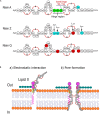Combating Antimicrobial Resistance With New-To-Nature Lanthipeptides Created by Genetic Code Expansion
- PMID: 33250877
- PMCID: PMC7674664
- DOI: 10.3389/fmicb.2020.590522
Combating Antimicrobial Resistance With New-To-Nature Lanthipeptides Created by Genetic Code Expansion
Abstract
Due to the rapid emergence of multi-resistant bacterial strains in recent decades, the commercially available effective antibiotics are becoming increasingly limited. On the other hand, widespread antimicrobial peptides (AMPs) such as the lantibiotic nisin has been used worldwide for more than 40 years without the appearance of significant bacterial resistance. Lantibiotics are ribosomally synthesized antimicrobials generated by posttranslational modifications. Their biotechnological production is of particular interest to redesign natural scaffolds improving their pharmaceutical properties, which has great potential for therapeutic use in human medicine and other areas. However, conventional protein engineering methods are limited to 20 canonical amino acids prescribed by the genetic code. Therefore, the expansion of the genetic code as the most advanced approach in Synthetic Biology allows the addition of new amino acid building blocks (non-canonical amino acids, ncAAs) during protein translation. We now have solid proof-of-principle evidence that bioexpression with these novel building blocks enabled lantibiotics with chemical properties transcending those produced by natural evolution. The unique scaffolds with novel structural and functional properties are the result of this bioengineering. Here we will critically examine and evaluate the use of the expanded genetic code and its alternatives in lantibiotics research over the last 7 years. We anticipate that Synthetic Biology, using engineered lantibiotics and even more complex scaffolds will be a promising tool to address an urgent problem of antibiotic resistance, especially in a class of multi-drug resistant microbes known as superbugs.
Keywords: RiPPs; chemoselectivity; genetic code expansion; lantibiotics; nisin; non-canonical amino acids; superbugs; synthetic biology.
Copyright © 2020 Karbalaei-Heidari and Budisa.
Figures







Similar articles
-
Prospects of In vivo Incorporation of Non-canonical Amino Acids for the Chemical Diversification of Antimicrobial Peptides.Front Microbiol. 2017 Feb 2;8:124. doi: 10.3389/fmicb.2017.00124. eCollection 2017. Front Microbiol. 2017. PMID: 28210246 Free PMC article.
-
Lantibiotics: promising candidates for future applications in health care.Int J Med Microbiol. 2014 Jan;304(1):51-62. doi: 10.1016/j.ijmm.2013.09.003. Epub 2013 Sep 4. Int J Med Microbiol. 2014. PMID: 24210177 Review.
-
Expanding the Genetic Code of Lactococcus lactis and Escherichia coli to Incorporate Non-canonical Amino Acids for Production of Modified Lantibiotics.Front Microbiol. 2018 Apr 6;9:657. doi: 10.3389/fmicb.2018.00657. eCollection 2018. Front Microbiol. 2018. PMID: 29681891 Free PMC article.
-
Antibiotics synthesized by posttranslational modification.Annu Rev Microbiol. 1993;47:535-64. doi: 10.1146/annurev.mi.47.100193.002535. Annu Rev Microbiol. 1993. PMID: 8257108 Review.
-
Engineering hybrid lantibiotics yields the highly stable and bacteriocidal peptide cerocin V.Microbiol Res. 2024 May;282:127640. doi: 10.1016/j.micres.2024.127640. Epub 2024 Feb 9. Microbiol Res. 2024. PMID: 38350171
Cited by
-
Artificial Small Molecules as Cofactors and Biomacromolecular Building Blocks in Synthetic Biology: Design, Synthesis, Applications, and Challenges.Molecules. 2023 Aug 3;28(15):5850. doi: 10.3390/molecules28155850. Molecules. 2023. PMID: 37570818 Free PMC article. Review.
-
Synthesis of a Novel Lantibiotic Using Mutacin II Biosynthesis Apparatus.Microbiol Spectr. 2023 Feb 14;11(1):e0303022. doi: 10.1128/spectrum.03030-22. Epub 2023 Jan 16. Microbiol Spectr. 2023. PMID: 36645288 Free PMC article.
-
Rebooting life: engineering non-natural nucleic acids, proteins and metabolites in microorganisms.Microb Cell Fact. 2022 May 28;21(1):100. doi: 10.1186/s12934-022-01828-y. Microb Cell Fact. 2022. PMID: 35643549 Free PMC article. Review.
-
Investigating the Specificity of the Dehydration and Cyclization Reactions in Engineered Lanthipeptides by Synechococcal SyncM.ACS Synth Biol. 2023 Jan 20;12(1):164-177. doi: 10.1021/acssynbio.2c00455. Epub 2022 Dec 15. ACS Synth Biol. 2023. PMID: 36520855 Free PMC article.
-
Characterization of Pseudomonas sp. NIBR-H-19, an Antimicrobial Secondary Metabolite Producer Isolated from the Gut of Korean Native Sea Roach, Ligia exotica.J Microbiol Biotechnol. 2022 Nov 28;32(11):1416-1426. doi: 10.4014/jmb.2208.08043. Epub 2022 Oct 21. J Microbiol Biotechnol. 2022. PMID: 36310358 Free PMC article.
References
-
- Adhikari S., Leissa J. A., Karlsson A. J. (2019). Beyond function: engineering improved peptides for therapeutic applications. AIChE J. 66:e16776 10.1002/aic.16776 - DOI
Publication types
LinkOut - more resources
Full Text Sources

